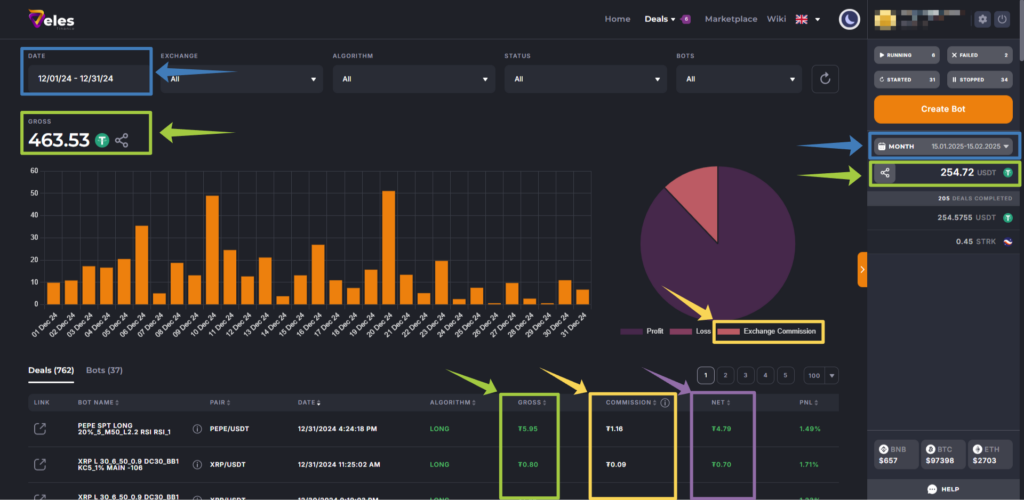It is very important for a trader to see the full picture of his work, including all the results of the trades and changes in the exchange balance sheet. You can use a paper notebook or spreadsheets for this, but there are also applications called Trader’s Diary. Just like the Veles service, they connect to your exchange account via the API, but with read-only access, save records from there and provide this information in a convenient way.
There is a “Statistics” section on the Veles website, but please note – this is not a Trader’s Diary (it does not show you the whole result).
The purpose of the “Statistics” section on the Veles website is to show you the basis for calculating the service’s commission. That is, its task is to determine the Gross profit, which is the result of the difference between opening and closing orders. Our platform will calculate 20% of the Gross profit received in the deal and deduct it from the balance in the user’s personal account. If the Gross result is negative, the service commission is not deducted.
For the user, this total is only an interim one, and not what will be credited to the exchange balance. The exchange’s trading fee must be deducted from the Gross Profit, and we get a Net profit.
When trading on a Spot, Net profit is what is credited to your exchange balance.
In the case of trading on Futures, this result is also intermediate, since it does not take into account the exchange “Funding fee”. We do not show data on the Funding fee, as the platform currently does not have such permissions.
The Gross profit can be calculated not for all trades, but only for those where the Take Profit or Stop Loss set by the bot was executed. Some of the deals end up with errors (this includes liquidations), some of the deals may be cancelled – therefore, there are no totals for them in our table, and to summarize the results, you will have to refer to the Trading History section on your exchange.
.
But the Gross profit can be calculated not for all deals, but only for those where the take profit or stop loss order set by the bot has worked. Some deals are stopped with errors (this includes liquidations), some deals are canceled – therefore, there are no totals for them in the table.
There is also no data on exchange funding fee – for this, Veles would need a different set of permissions.

On the page https://veles.finance/cabinet/statistics can be seen:
Gross (green frame) is the difference between the opening and closing orders. Gross is shown in USDT (although in fact it may come in different currencies, depending on the bot settings). The profit distribution for individual currencies is shown on the right side, under the total amount in USDT.
On the right side of the page, the amount of profit is shown by default for the last 30 days. Since the profit is uneven by month, you will see both an increase and a decrease in this amount – this is normal. Change the date filter to see a different total.
Note. If you only trade Futures, and you see profits in other currencies, then this is the result of trading errors when the bots did not balance the trades. In this case, these coins were simply designated as profits, but in fact they do not exist (for more information in this article: https://help.veles.finance/en/bot-notifications/).
Net (purple frame) is Gross minus the exchange trading commission. Funding fee is not taken into account here.
Commission (yellow frame) is the exchange trading commission (the Veles commission is shown on another page, https://veles.finance/cabinet/account/balance). The amounts of this commission are received from the exchange in the report on each executed order. The exchange’s commission in the table is indicated in USDT and is calculated at the exchange rates at the time of closing the deal. If the commission for the BTC/ETH deal is taken in ETH or BTC, then the table will indicate it in USDT. If it’s in BNB, then there will be a dash (no information).
Note. If the exchange’s commission is less than 0.01, then there will be dashes in the column, although it is cumulative in the total amount.
Read more about exchange commissions: https://help.veles.finance/en/exchange-transaction-fees/
The date filter (blue frames) on the right and left sides of the screen are configured independently of each other, so the totals of the results may vary. There may also be a slight difference due to rounding.
P&L (PNL) on the exchange and P&L at Veles are different parameters in meaning, although they are called the same way. On Veles, this is a measure of the net price movement. On the exchange, P&L is taking into account the leverage. It turns out that 1% P&L on Veles is 10% P&L on the exchange with x10 leverage.
Also note that in the windows where you share the results of a trade, sometimes it is not Profit-and-Loss (PnL) that is indicated, but Return on Investment (ROI = P&L / initial margin) value.
Generally speaking, in the case of Futures trading, we recommend checking the “Closed P&L”, “Positions” (not “Orders”) section on the exchange – these are your totals for your deals. Do not focus on the page with the PnL chart on the exchange, which you see first of all in the terminal or in the application. It shows information about the total Unrealized P&L, which includes all currently open positions – and they are usually negative, this is normal.
Alternatively, you can connect an external trader’s diary (examples of such diaries are TradersDiaries, TabTrader, TraderMakeMoney, etc.). This application takes your statistics from the exchange and provides it in a more convenient form (although each of them has its own limitations).
When trading on the Spot, your correct trading result is shown by the Statistics on the Veles website. But only for deals finished by the bot, without errors.






